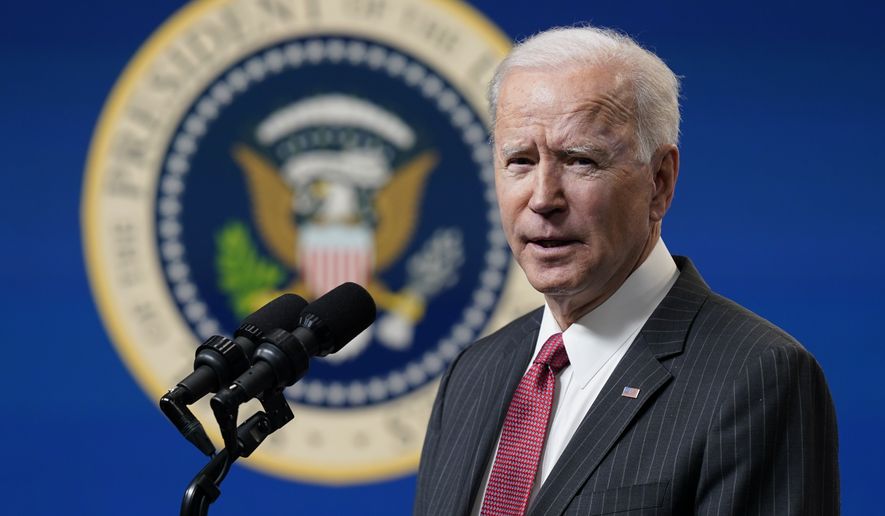OPINION:
While he pledged during the 2020 campaign to unite the country and work with politicians from both parties, Joe Biden’s first legislative act as president is to push a partisan $1.9 trillion spending package over the objections of Republican lawmakers.
President Biden and congressional Democrats are pushing this proposal through a process known as “budget reconciliation,” which allows the left to steamroll Republicans and pass their proposal with 50 votes in the Senate.
The Biden administration is proposing this new spending even though Congress has already enacted over $4 trillion in aid, according to the Committee for a Responsible Federal Budget. Of this, $1 trillion is unspent and $900 billion was passed by lawmakers and signed into law less than two months ago.
This amount also does not include the $700 billion that has been allocated by administrative action and $2.6 trillion that has been spent by the Federal Reserve.
To put this spending in context, there are 122.8 million households in the U.S. and 79.5 million households, according to the Census Bureau. By either metric, we have spent a significant amount of taxpayer dollars already — $51,500 per family and $33,380 per household has already been spent. Mr. Biden’s $1.9 trillion plan would spend an additional $15,500 per household or $23,900 per family.
Even if it is determined that further aid is needed (which is not the case), it should be narrowly targeted to Americans that have been harmed by the pandemic. While it is indisputable that millions of Americans have seen significant financial hardships due to the pandemic, there are also many Americans who have kept their jobs and are not financially worse off.
In fact, some Americans are saving more because they cannot spend their disposable income on travel, restaurants, or other recreation. This is borne out in the data. According to the Bureau of Economic Analysis, personal saving as a percentage of income in 2020 was 16.4 percent, more than double the pre-pandemic rate in 2019, which was just 7.5 percent.
Even former Clinton Treasury Secretary and Obama Chief Economic Adviser Larry Summers has expressed skepticism with Mr. Biden’s plan. Writing in The Washington Post, Summers argued that Mr. Biden’s stimulus plan is three to six times larger than the economic shortfall and that it will result in wasteful spending that threatens to cause future financial instability and unnecessary inflation.
The Biden plan proposes spending the $1.9 trillion on various liberal spending priorities. For instance, the Biden stimulus plan calls for hundreds of billions in refundable tax credits. Much of this is not tax reduction but rather a spending outlay. Based on past history of refundable credits, there is significant risk that this proposal will result in additional waste, fraud, and abuse.
For instance, a 2020 report by the Treasury Inspector General for Tax Administration (TIGTA) found that 25 percent (or $17.4 billion) worth of Earned Income Tax Credit (EITC) payments made in 2019 were improper. Other reports have found a comparable rate of improper payments for the additional child tax credit, which is the refundable portion of the $2,000 child tax credit.
The plan also contains a $400 per-week additional unemployment benefit that lasts until September and would discourage out-of-work Americans from returning to their jobs. This policy would be in addition to existing state-based unemployment programs and creates a situation where some workers will be paid more than they were at their jobs. In fact, according to the American Action Forum, half of American workers could make more on unemployment with the $400 per week benefit.
In addition to these payments, Mr. Biden is calling to raise double the federal minimum wage to $15 per hour, a proposal that will eliminate 1.4 million jobs and crush small businesses at a time that they are especially vulnerable.
Finally, Mr. Biden’s proposal calls for $350 billion in state and local spending even though many states have seen little or no negative budgetary impact because of the pandemic. For instance, California recently reported a $15 billion budget surplus, while Wisconsin expects to have money to contribute to its rainy-day fund, Maryland has increased its revenue projections, and Minnesota expects a surplus.
In all, state collections declined just 4.4 percent through September compared to the first nine months of 2019, according to the Tax Foundation. Moreover, Congress has also already provided aid to states, including approximately $360 billion that directly went to state and local governments to help them respond to COVID-19.
Mr. Biden’s $1.9 trillion COVID-19 stimulus plan comes at a time when we have already spent trillions of dollars. Not only will this result in new wasteful spending, but it is unclear how useful this plan will be to help the country through the pandemic. Instead, this plan appears designed to further the left’s long-held policy goals.
• Alex Hendrie is director of tax policy at Americans for Tax Reform.




Please read our comment policy before commenting.